About the "Guzzi", also in this field this great motorcycle were at the state-of-the-art one: in fact, it was among the first ones to adopt the elastic suspension. Actually to then the frames were rigid and the rear suspension didn't exist, the suspension was submitted to of the big springs under the saddle; in the past people believed that an elastic suspension was even dangerous for the stability of the motorbike. However here some examples of rear suspension:
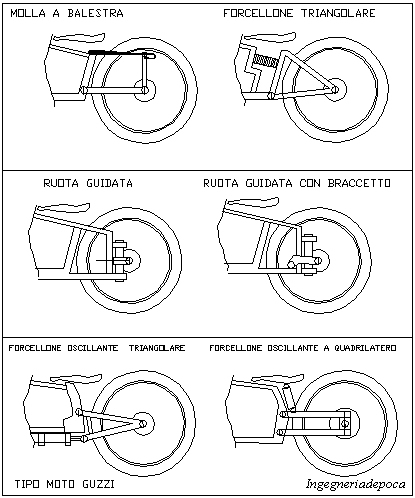
Classic
"Guzzi" rear suspension layout
Only in 1928 the "Guzzi" produced the model "G.T." (the "Norge", for a famous "raid" demonstrative thin in Norway), shown in the following photo:
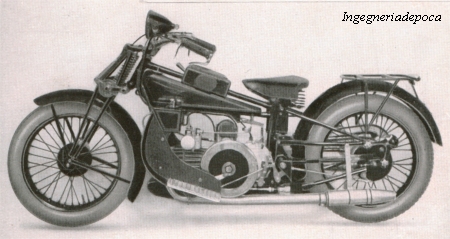
"Moto Guzzi G.T. Norge"
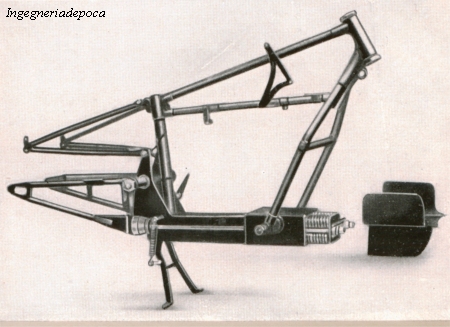
Photo
frame "G.T. Norge" (1928)
This model was not successful (only 78 motorcycles were produced) because the distrust of an elastic suspension. So this model was "unpopular". Obviously it is now a rare piece from collection, both the model and its peculiar suspension.
About the constructive principles, the package of the springs is positioned in the lowest possible point advantage of the centroid. It was connected to the big fork with some long rods.
About the constructive principles, the package of the springs is positioned in the lowest possible point advantage of the centroid. It was connected to the big fork with some long rods. Only after the resounding victory at "Tourist Trophy" (1935) "Moto Guzzi class 250" with elastic frame that convinced the public opinion to believe in this new technology. Firstly this idea was aplied to military authorities ("Moto Guzzi" was the Italian Army official supply company); in-fact the first model was expressly realized for the Army. The "G.T. 17" already had the elastic frame as the "G.T. Norge". The following image of the "G.T. 17" original catalog with the components of the frame, of which we have realized the engine support (underlined in red) here shown inthe right lower part.
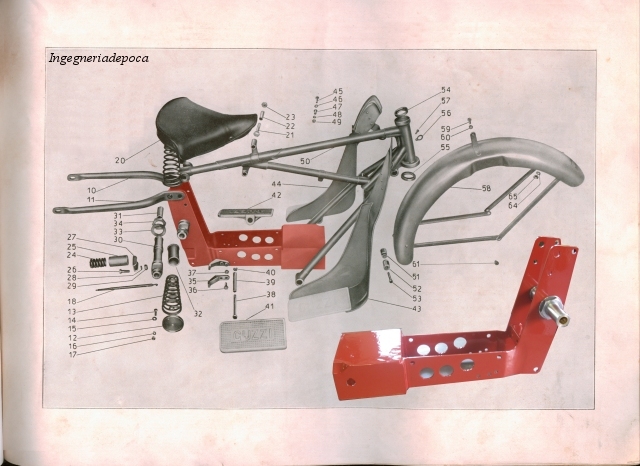
Motorbike elastic Guzzi GT16 - GT17 - GT2VT: Realization of a frame part.
The piece realized by "Ingegneriadepoca" (the support for the
engine) is in the right lower
part, as an "exploded" of a catalog of epoch.
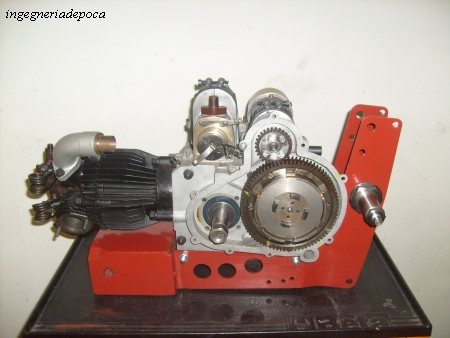
The support for the engine, realized from "Ingegneria d'epoca" (models GT16 - GT17 - GT2VT)

The
first Moto Guzzi mass-production was "Normale" bike model,
in 1921. The frame was very rigid in the rear part of the bike,
according to the Twenty's technology; the shown diagram is an example. The mixed structure
(tubes and plates), creates a rigid assembly, enough for the performance
in that period, we remember that motorbike frames were derived from
bicycles just a decade earlier. The dinghy realized fusion of the hubs on which the tubes penetrate both the horizontal and vertical, the rear part made of folded sheet also supports the arms of the swingarm. Finally the robust plates on which supports the engine and which connects the rear part with the front. The method of union of
tha epoch, we already described in the various volumes of Ingegneriadepoca is that of brazing and welding and pinning the sheets for hot riveting. In addition, the chosen design is intended to be a technical and aesthetic point of view coincide in a balance of elegance, simplicity and functionality just like for the engine make the
"Normale" a masterpiece of "good engineering."